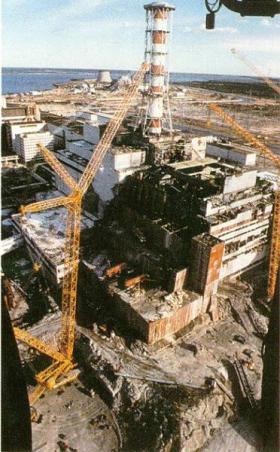Difference between revisions of "International Nuclear Event Scale"
m |
(Chernobyl travels) |
||
| Line 50: | Line 50: | ||
* http://gnssn.iaea.org/regnet/Pages/INES.aspx | * http://gnssn.iaea.org/regnet/Pages/INES.aspx | ||
* http://www.iaea.org/Publications/Factsheets/English/ines.pdf | * http://www.iaea.org/Publications/Factsheets/English/ines.pdf | ||
| + | * Irresponsible: [http://wikitravel.org/en/Chernobyl guided tours to the nuclear exclusion zone of the catastrophe] - caution! This article downplays the risks of radiation while scientific sounding data is mentioned without telling that any additional radiation dose is to be avoided. They don't speak about the alpha and beta radiation regular ''Geiger counters'' can't detect. Don't trust travel agencies promoting adventure trips to atomic disaster zones - there safety measures and advice will probably again underestimate the actual threats. | ||
Revision as of 13:25, 4 May 2012
After the Chernobyl accident, the International Nuclear Event Scale (INES) has enhanced reporting on events at nuclear power plants[1]. It was implemented in 1990[2]. The UN's International Atomic Energy Agency (IAEA) describes INES as a tool for "promptly communicating to the public in consistent terms" what a nuclear episode means[2]. It has three factors: radioactivity releases to the public; barriers against radiation at a nuclear site; and civil-defence measures[2].
In the INES the events are roughly divided into deviations, incidents and accidents[1]. The events are classified on the Scale at seven levels[1]. Each increase in level on the scale indicates a roughly 10-fold increase in severity[2].
The lower levels (1-3) are termed incidents[1]. The upper levels (4-7) are termed accidents[1]. The events which have no safety significance are classified as level 0/below scale[1]. They are termed deviations[2][1]. The lower levels consists of anomalies, incidents and serious incidents[1]. The upper levels are comprised of accidents without significant off-site risk, accidents with off-site risk, serious accidents and major accidents[1].
Description of INES levels
- Minor problem with safety components at a nuclear facility, but significant safety margin remaining
- INES 2: Incident[2]
- Radiation levels in an operating area of a nuclear facility of more than 50 millisieverts (mSv) per hour. Exposure of a member of the public to radiation in excess of 10 mSv, exposure of a worker in excess of statutory annual limits.
- INES 3: Serious Incident[2]
- Severe contamination in an area of a facility, with non-lethal injuries such as radiation burns. Low probability of significant public exposure.
- INES 4: Accident with local consequences[2]
- Partial meltdown or damage to fuel, release of significant quantities of radioactive material within an installation. No counter-measures likely to be needed other than local food controls.
- INES 5: Accident with wider consequences[2]
- Severe damage to reactor core, large quantities of radioactive material released within a site. Limited release of material to the wider environment, requiring implementation of some planned countermeasures.
- INES 6: Serious accident[2]
- Significant release of radioactive material likely to require implementation of planned countermeasures.
- INES 7: Major accident[2]
- Major release of radioactive material with widespread health and environmental effects, requiring implementation of planned and extended countermeasures.
Examples of INES accidents
INES 7:
- 1986 Chernobyl (Pripyat) (UA)[2] - meltdown and explosion
- 2011 Fukushima (J)[3] - several meltdowns and explosions
INES 6:
INES 5:
Other concepts
In Germany accidents up to INES level 4 are called GAU (German for größter anzunehmender Unfall) refering to the US-American concept of the maximum credible accident a nuclear plant needed to be prepared for. Accidents of higher level are called Super-GAU as their impacts are even bigger than the biggest accidents the plant concepts necessarily have to deal with.[4].
Atomic catastrophe information network
The IAEA maintains an information exchange network between the countries participating in the use of the Scale. Reports on the events belonging to the level 2 or above it are submitted to the IAEA through the NEWS (Nuclear Event Web-based System). The IAEA should have information on the level of the event in its disposal within 24 hours.[1]
The event level is defined in the country where the event takes place.[1]
Further information
- http://gnssn.iaea.org/regnet/Pages/INES.aspx
- http://www.iaea.org/Publications/Factsheets/English/ines.pdf
- Irresponsible: guided tours to the nuclear exclusion zone of the catastrophe - caution! This article downplays the risks of radiation while scientific sounding data is mentioned without telling that any additional radiation dose is to be avoided. They don't speak about the alpha and beta radiation regular Geiger counters can't detect. Don't trust travel agencies promoting adventure trips to atomic disaster zones - there safety measures and advice will probably again underestimate the actual threats.
- ↑ 1.00 1.01 1.02 1.03 1.04 1.05 1.06 1.07 1.08 1.09 1.10 http://www.stuk.fi/ydinturvallisuus/ydinvoimalaitokset/vakavuusasteikko/en_GB/asteikko/ as at December 10, 2010
- ↑ 2.00 2.01 2.02 2.03 2.04 2.05 2.06 2.07 2.08 2.09 2.10 2.11 2.12 2.13 2.14 2.15 2.16 http://www.smh.com.au/environment/energy-smart/world-scale-for-rating-nuclear-accidents-20110412-1dc3m.html as at April 12, 2011
- ↑ http://en.wikipedia.org/w/index.php?title=International_Nuclear_Event_Scale&oldid=423691959 as at April 13, 2011
- ↑ http://de.wikipedia.org/w/index.php?title=Auslegungsst%C3%B6rfall&oldid=86847110 as at March 24, 2011


